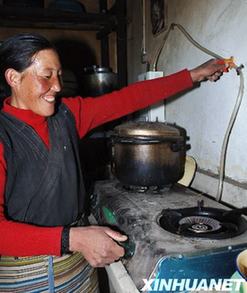In the past, the national and local governments invested a lot in developing wind and methane projects to tackle Tibet's energy challenges.
But wind turned out to be unsuitable as a source of renewable energy, because the turbines only collect wind from a specific direction and most villages cannot maintain the equipment, rendering the turbines useless.
 The methane project was even more difficult to popularize, because it is technically difficult to heat animal waste to a high enough temperature to produce methane in an area where it is cold all year round. Moreover, the high cost of methane capture methods makes it financially unviable.
The methane project was even more difficult to popularize, because it is technically difficult to heat animal waste to a high enough temperature to produce methane in an area where it is cold all year round. Moreover, the high cost of methane capture methods makes it financially unviable.
But Tibet is blessed with an abundance of sunshine and solar power could be the best option.
"Tibet is the nearest place on earth to the sun and there are more than 3,000 hours of sunshine annually," Tsering Norbu said.
The new house, which uses solar power, was the brainchild of the China National Engineering Research Center for Human Settlements, Tsinghua University, and a local science and technology association. The houses have a "passive" solar design that uses roof angles and window placement to assist heating and cooling.
They also have better insulation and high-efficiency appliances.
"The house can be heated up to 10 degrees using half of the amount of cow dung previously needed," said Dr. Xiao Wei from Tsinghua University.
The "green" houses cost 40,000 yuan, more than a conventional house. But Zeng Yan said substituting cheaper, local materials would make the houses affordable.
In addition, Dupont is considering giving loans to poor farmers and herdsmen to help them build houses.
The government of the Tibet Autonomous Region has been giving housing subsidies to farmers and herdsmen since it launched a project in 2006 that has so far provided safe and comfortable houses to over 110,000 families. In 2008, 676.75 million yuan (US$ 99 million) was allocated to help 52,000 families find homes.
In the years to come, the government is aiming to cover 80 percent of farmers and herdsmen with the project.
"If the 'green' houses are successful, the government will step in and help roll out our design," Zeng Yan said.
(China.org.cn by He Shan, February 6, 2009)